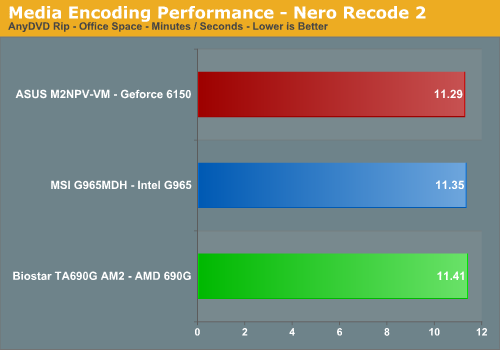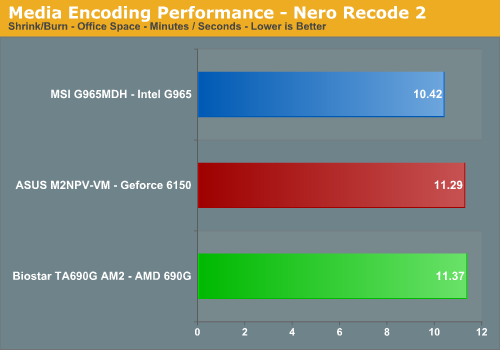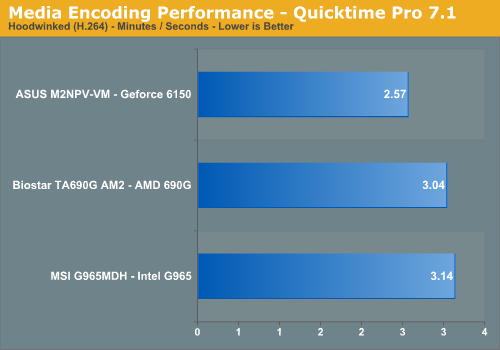Media Encoding Performance
A traditional weak spot of the current AM2 processor offerings has been in the media encoding arena when compared to the Intel Core 2 Duo. Considering the main optimizations for the Core 2 Duo centered on overall media encoding performance, we were very interested in seeing how this platform compared to current AMD lineups. We are utilizing an updated video encoding test suite for this article that includes AnyDVD, Nero Recode 2, Windows Media Encoder 9, and QuickTime Pro 7.1.
Our first series of tests is quite easy - we take our original Office Space DVD and use AnyDVD and Nero Recode 2 to copy the full DVD to the hard drive without compression, thus providing an almost exact duplicate of the DVD. We then fired up Nero Recode 2, selected our Office Space copy on the hard drive, and performed a shrink operation to allow the entire movie along with extras to fit on a single 4.5GB DVD disc. We then go back and use Nero Recode to shrink the full DVD copy and burn it onto our DVD disc. We left all options on their defaults except we checked off the advanced analysis option. The scores reported include the full encoding process and are represented in minutes/seconds, with lower numbers indicating better performance.



The results are very interesting as we did not expect our AM2 systems to perform this well and to do so is very surprising when reviewing other media encoding results. In fact, we ran the test several times and verified our settings before accepting the test results. Perhaps the last few months of Core 2 Duo results constantly exceeding AM2's best by a wide margin have tainted our cognitive abilities.
Of course, we are using a mid-range AM2 processor against the budget C2D part (the AMD price cuts have helped matters there, as the price difference is currently only about $35) but we fully believe the majority of the performance difference lies in the chipset selection on the AM2 systems. It is only in the shrink and burn tests that we see the Intel platform flexing its muscles. The difference in the shrink portion of this test was minimal and mirrored our individual shrink test results. We noticed our Intel platform was able to feed data to our DVD drive in a consistent manner with each of the AM2 platforms suffering from stutters several times resulting in our drive slowing down during the burn process. It was difficult to figure out if this was a driver, disk controller, or CPU issue. We are still testing on other chipset and CPU combinations.
Our next test has us converting our day at the beach AVI file into a high definition WMV file suitable for our Aunt Gertrude to view on her new high definition LCD TV. We ensured our quality settings were set for High Definition output. The remaining options are left at default values and then we let this program do its magic. We are reporting the numbers in minutes/seconds to complete the conversion.

These results left our heads shaking and we busily scurried off to the far corners of the lab looking for answers. After several test repeats, a few new images, and a couple of drinks, we stand by the results. Our answer, which we came up with after we switched out the MSI G965 board for a Gigabyte G965 board and had the same results, is that our E6300 is just incapable of keeping up with our AM2 5200+ X2 in this test. Why? It's all about the cache and CPU speed. Our E6600 trounces the 5200+ X2 at stock speeds and scores near it when running at E6300 speeds thanks to the increased cache. Meanwhile, our E6400 is just slightly off the 5200+ X2 pace at a modest 300MHz increase in speed over the E6300.
Next on the list is our QuickTime Pro 7.1 test that will convert our newly downloaded .Mov file into a plasma screen pleasing H.264 format. We ensured our quality settings were set to their highest levels and then let the horses loose. The values reported are again in minutes/seconds for the conversion time, with lower numbers being better.

Once again, the AM2 platforms have a slight advantage with the 6150 scoring outside of the norm in this test - so far outside that we thought something was not kosher in the land of NVIDIA. Fortunately for us, the answer was easy once we reviewed the playback files. It seems as though the quality of our encoding results on the NVIDIA platform left much to be desired along with numerous frames missing during playback or other frames just tangled together at times. We ran this same test under XP without an issue so our first blip with Vista has now occurred. Our video images are presented below.
In these particular screen shots both the G965 and 690G image quality results are basically even, but the 6150 is showing a case of the jaggies at full screen resolution. The entire playback file suffered from this issue.
A traditional weak spot of the current AM2 processor offerings has been in the media encoding arena when compared to the Intel Core 2 Duo. Considering the main optimizations for the Core 2 Duo centered on overall media encoding performance, we were very interested in seeing how this platform compared to current AMD lineups. We are utilizing an updated video encoding test suite for this article that includes AnyDVD, Nero Recode 2, Windows Media Encoder 9, and QuickTime Pro 7.1.
Our first series of tests is quite easy - we take our original Office Space DVD and use AnyDVD and Nero Recode 2 to copy the full DVD to the hard drive without compression, thus providing an almost exact duplicate of the DVD. We then fired up Nero Recode 2, selected our Office Space copy on the hard drive, and performed a shrink operation to allow the entire movie along with extras to fit on a single 4.5GB DVD disc. We then go back and use Nero Recode to shrink the full DVD copy and burn it onto our DVD disc. We left all options on their defaults except we checked off the advanced analysis option. The scores reported include the full encoding process and are represented in minutes/seconds, with lower numbers indicating better performance.



The results are very interesting as we did not expect our AM2 systems to perform this well and to do so is very surprising when reviewing other media encoding results. In fact, we ran the test several times and verified our settings before accepting the test results. Perhaps the last few months of Core 2 Duo results constantly exceeding AM2's best by a wide margin have tainted our cognitive abilities.
Of course, we are using a mid-range AM2 processor against the budget C2D part (the AMD price cuts have helped matters there, as the price difference is currently only about $35) but we fully believe the majority of the performance difference lies in the chipset selection on the AM2 systems. It is only in the shrink and burn tests that we see the Intel platform flexing its muscles. The difference in the shrink portion of this test was minimal and mirrored our individual shrink test results. We noticed our Intel platform was able to feed data to our DVD drive in a consistent manner with each of the AM2 platforms suffering from stutters several times resulting in our drive slowing down during the burn process. It was difficult to figure out if this was a driver, disk controller, or CPU issue. We are still testing on other chipset and CPU combinations.
Our next test has us converting our day at the beach AVI file into a high definition WMV file suitable for our Aunt Gertrude to view on her new high definition LCD TV. We ensured our quality settings were set for High Definition output. The remaining options are left at default values and then we let this program do its magic. We are reporting the numbers in minutes/seconds to complete the conversion.

These results left our heads shaking and we busily scurried off to the far corners of the lab looking for answers. After several test repeats, a few new images, and a couple of drinks, we stand by the results. Our answer, which we came up with after we switched out the MSI G965 board for a Gigabyte G965 board and had the same results, is that our E6300 is just incapable of keeping up with our AM2 5200+ X2 in this test. Why? It's all about the cache and CPU speed. Our E6600 trounces the 5200+ X2 at stock speeds and scores near it when running at E6300 speeds thanks to the increased cache. Meanwhile, our E6400 is just slightly off the 5200+ X2 pace at a modest 300MHz increase in speed over the E6300.
Next on the list is our QuickTime Pro 7.1 test that will convert our newly downloaded .Mov file into a plasma screen pleasing H.264 format. We ensured our quality settings were set to their highest levels and then let the horses loose. The values reported are again in minutes/seconds for the conversion time, with lower numbers being better.

Once again, the AM2 platforms have a slight advantage with the 6150 scoring outside of the norm in this test - so far outside that we thought something was not kosher in the land of NVIDIA. Fortunately for us, the answer was easy once we reviewed the playback files. It seems as though the quality of our encoding results on the NVIDIA platform left much to be desired along with numerous frames missing during playback or other frames just tangled together at times. We ran this same test under XP without an issue so our first blip with Vista has now occurred. Our video images are presented below.
 690G - Click to enlarge |
 G965 - Click to enlarge |
 6150 - Click to enlarge |
In these particular screen shots both the G965 and 690G image quality results are basically even, but the 6150 is showing a case of the jaggies at full screen resolution. The entire playback file suffered from this issue.










70 Comments
View All Comments
SignalPST - Tuesday, March 6, 2007 - link
I'm interested in this topic as well.Then again, I still waiting for them to come out with a HDMI sound card.
StriderGT - Wednesday, March 7, 2007 - link
Unfortunately there are lots of us who are still waiting for a true HDMI PC audio solution. You can check the thread I started with many technical details for that matter here: http://www.avsforum.com/avs-vb/showthread.php?t=79...">http://www.avsforum.com/avs-vb/showthread.php?t=79...Patrese - Tuesday, March 6, 2007 - link
Great review, thanks... I know I asked that a couple times already, but is there a mATX roundup planned here at AT? I'd like to see the Asus M2NPV-VM and Abit NF-M2 NView compared with its 690G counterparts, as this segment makes for most of the computer sales on most places? BTW, weren't you plaged by memory compatibility issues with the M2NPV-VM oe any of the boards tested? This Asus board showed extremely picky on my experience...Gary Key - Wednesday, March 7, 2007 - link
The roundup is scheduled on the 19th, trying to pull it in. What BIOS and memory are you using on the M2NPV-VM, so far I have not run into any real issues except with 2GB modules. The abit board is one of my favorites so far. ;)Patrese - Tuesday, March 6, 2007 - link
There shouldn't be a question mark at the end of the "most sales" phrase... There are also a couple typos, sorry about that. Where's the edit button anyway? ;)RamarC - Tuesday, March 6, 2007 - link
i don't really understand the point of comparing chipsets/motherboards between processor families. subsystem performance figures can show glaring deficiencies but otherwise it really boils down to a cpu comparison. the "media/audio encoding" and "media performance" sections are certainly cpu-centric. and pitting a $230 x2 5200+ against a $185 e6300 winds up handicapping the intel contestant. shouldn't the $222 e6400 have been used instead?Gary Key - Tuesday, March 6, 2007 - link
As stated in the article, AMD is marketing the AM2 and 690G/V as a platform design to compete against the G/Q965 and Core 2 Duo solution. The 690G is targeted to the multimedia, HTPC, home/office, casual gaming crowd and was tested as such. We looked at the total price of a base Core 2 Duo and decent G965 board and then matched the processor choice that would come closest to the price and performance of the Intel offering while meeting the platform cost. Our tests were chosen based upon the target audience for each platform in the home environment. This was not a review of office level machines as the Q965/963 and 690V are targeted to the business user.JarredWalton - Tuesday, March 6, 2007 - link
The conclusion mentions that the G965 + E6300 costs around $300 compared to $315 for the 690G + 5200+ (or 6150 + 5200+), so it's more or less a fair "equivalent price" platform comparison. The E6400 ends up being faster than the E6300, but still slower in a few tests (as the text mentions) and even faster in those tests where E6300 already holds the lead. Nothing new there - we've pretty much beat the "Core 2 Duo is faster" drum to death. We feel anyone looking at 690G is going to be interested in the platform as a whole much more than whether or not it is faster than equivalently price Core 2 offerings.mostlyprudent - Tuesday, March 6, 2007 - link
There may be too many variables, but perhaps you could come up with a way to normalize the benchmarks. For instance, run the gaming tests first with ultra high-end graphics to try and isolate the performance delta for each plattofrm/cpu combo you will test with. Then run the game benchmarks with the IGP solutions and adjust the scores based on the previous tests. Just a thought off the top of my head.asliarun - Tuesday, March 6, 2007 - link
Ah, but you're evaluating a chipset here, not a platform or a system solution. Having said that, I agree that it IS difficult to compare chipsets that are targeted for different CPUs. In such a case, a better way to evaluate might be to take an AMD and an Intel CPU that is similar in performance (not in price), and use them to compare their corresponding chipsets. That would highlight the differences between the chipsets. You could always mention the price alongside, or do a separate price/performance comparison alongside.My point is that a price/performance comparison should complement a pure performance comparison, not the other way around.